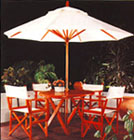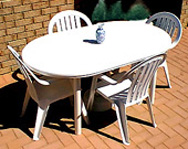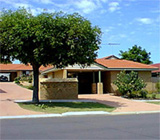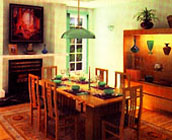
Hay un
perro de
|
|

Hay 4 sillas en la mesa de la baranda. |
|

En el patio de casa hay una mesa con cuatro sillas. |

Hay varias plantas alrededor de la casa. |

En el comedor hay una lámpara y seis tazas verdes. |
| Lesson 101 |
In this lesson you will learn the
use of the expression 'hay'.
| there is | |
| hay | |
| there are |
Hayis used when you want to indicate an amount or when you are counting.
Read the sentences below and pay
attention how to use hay.

Hay un
perro de
|
|

Hay 4 sillas en la mesa de la baranda. |
|

En el patio de casa hay una mesa con cuatro sillas. |

Hay varias plantas alrededor de la casa. |

En el comedor hay una lámpara y seis tazas verdes. |
Hay is used in singular and plural sentences.
Situaciones en tiempo presente.
Ejemplos:
| Hay una planta en el comedor. | En esta casa hay dos árboles. | ||
| Sobre la mesa del patio hay un vaso. | En el jardín hay muchas plantas y flores. | ||
| En el comedor hay una pintura. | En mi casa hay tres animales domésticos. | ||
| Allí hay una cabina telefónica. | En el estudio hay dos computadoras. |
| Class Activity 101a |
Students working in pairs, read the
sentences and complete the missing words.
| 1 | ....... un árbol grande al frente de la casa. |
| 2 | En el barrio ..... muchas casas y edificios. |
| 3 | En la calle ...... muchos autos y camiones. |
| 4 | En la casa de Pedro ......... varios aparatos eléctricos. |
| 5 | ....... cuatro (4) sillas alrededor de la mesa. |
| 6 | En al playa ....... mucha gente y muchos quitasoles. |
| 7 | ...... dos litros de leche en la nevera. |
| 8 | ....... mil dólares en mi cartera negra. |
Note: Haycan go at the beginning of the sentence or in the centre.
| Class Activity 101b |
Now, have a look at Las
partes de una casa and familiarise yourself with the vocabulary.
You will be required to use this
vocabulary in your class discussion and tasks.
a) Make a printout of the house plan and label rooms.
b) Write one page about La
Región
de la Araucanía to be presented in the classroom for
evaluation.
When writing your topic consider the following:
| E- mail Task 101 |
|
Contesta
|
Email to your e-pal At the end of the Lab session write an e-mail to your e-pal in Chile. Introduce yourself and tell them about your family, your suburb and state where you live. Be communicative and express your
interest in the school learning network and the opportunity to chat with
them in a regular basis.
|
The e-mail must be sent to the classroom teacher for assessment.
Muy bien!
| Copyright © 2001, Ramona del Carmen Castillo |
Updated by: October
20, 2001
|